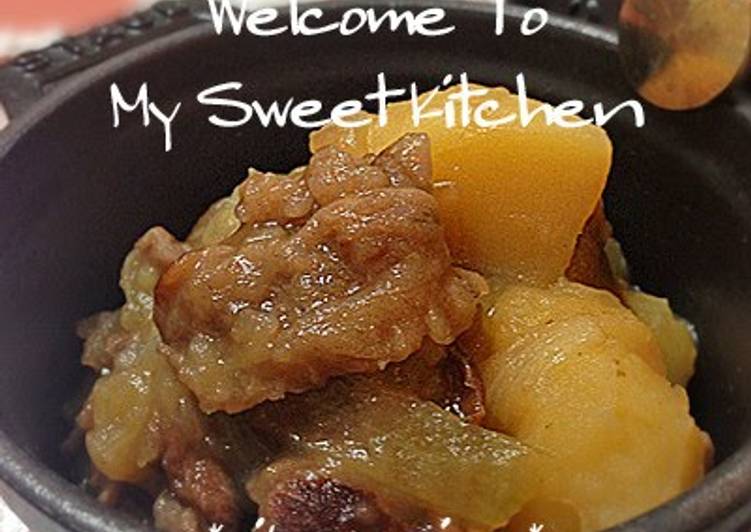Waterless Nikujaga (Simmered Meat and Potatoes) in a Staub Cocotte. Nikujaga is one of traditional dish in Japan. Most of the girls learn how to cook Nikujaga from their Waterless Nikujaga (Simmered Meat and Potatoes) in a Staub Cocotte. Nikujaga quite literally translates to "meat and potatoes" - niku means "meat" and jaga means "potatoes" in Japanese.
 Nikujaga (Japanese: 肉じゃが) literally means "meat and potatoes", from two Unlike Western stews, the simmering time is much shorter because nikujaga uses thinly sliced meat.
Nikujaga is one of the most popular Japanese comfort food, the delicious dish includes sliced beef.
It's a classic Japanese homecooking dish- savory potatoes and beef that have been fast simmered in a sweetened soy sauce!
You can cook Waterless Nikujaga (Simmered Meat and Potatoes) in a Staub Cocotte using 10 ingredients and 19 steps. Here is how you achieve that.
Nikujaga (Japanese: 肉じゃが) literally means "meat and potatoes", from two Unlike Western stews, the simmering time is much shorter because nikujaga uses thinly sliced meat.
Nikujaga is one of the most popular Japanese comfort food, the delicious dish includes sliced beef.
It's a classic Japanese homecooking dish- savory potatoes and beef that have been fast simmered in a sweetened soy sauce!
You can cook Waterless Nikujaga (Simmered Meat and Potatoes) in a Staub Cocotte using 10 ingredients and 19 steps. Here is how you achieve that.
Ingredients of Waterless Nikujaga (Simmered Meat and Potatoes) in a Staub Cocotte
- It's 100 grams of "A" Thinly sliced beef (cut into bite-sized pieces).
- It's 3 of "A" Potatoes (cut into 3-4 cm chunks).
- It's 1 large of "A" Onions (thinly sliced into about 1.5 cm slices).
- Prepare 1 1/2 tbsp of "B" Sugar.
- It's 2 tsp of "B" Mirin.
- You need 1 tbsp of "B" Sake.
- It's 1 tbsp of "B" Soy sauce.
- Prepare 4 pinch of "B" Dashi stock granules.
- Prepare 1 tsp of "C" Soy sauce.
- You need 1 of Vegetable oil (or beef fallow).
The Japanese navy chefs were ordered to create a version of.. Nikujaga (meat and potatoes in Japanese) is a homey dish made of simmered potatoes, onion, shirataki, and surprisingly just a bit of meat for Just like most Japanese simmered dishes (nimono 煮物) the ingredients are simmered in a sweetened broth flavoured with dashi, sake, and soy sauce. Suchen Sie nach Nikujaga Simmered Meat Potatoes Healthy Japanese-Stockbildern in HD und Millionen weiteren lizenzfreien Stockfotos, Illustrationen und Vektorgrafiken in der Shutterstock-Kollektion. Jeden Tag werden Tausende neue, hochwertige Bilder hinzugefügt.
Waterless Nikujaga (Simmered Meat and Potatoes) in a Staub Cocotte step by step
- Cut up the "A" ingredients. The size of the potatoes and carrots will affect the cooking time, so be sure to cut as instructed in the ingredients list..
- Heat a little oil (or beef fallow) in a Staub cocotte over medium head. Then, add the thinly sliced beef and cook until brown..
- Once browned, add the onions and potatoes from Step 1 and cook together..
- When the onions and potatoes are thoroughly coated in the oil, add the "B" seasonings and mix well..
- Once the seasonings have evenly coated the ingredients, cover with the lid and simmer for about 30 seconds over medium heat..
- After 30 seconds, reduce the heat to low. Then, set a timer for 10 minutes..
- After 10 minutes, open the lid and add the "C" soy sauce and mix well. Replace the lid and set the timer for 10 minutes..
- After 10 minutes, turn off the heat. Let sit with the lid on for 30 minutes to 1 hour to let it cool, allowing the flavors seep in..
- After at least 30 minutes, mix lightly without crushing the potatoes. *You can do this with a small wooden spoon, if you like..
- And now your super-delicious nikujaga is ready. The potatoes are so nice and fluffy, using only the moisture from the seasonings and vegetables..
- By allowing it to cool first, the flavors will really sink in and become delicious. Heat it up again just before serving..
- [Guideline for the ingredient amounts:] When you put all the ingredients into the cocotte (16 cm diameter), they should fill up about 80-85% of the cocotte, and the amounts of the listed seasoning ingredients should be just right..
- One of our family members dislikes carrots, so we don't add carrots. If you add carrots, replace a portion of the potatoes with the carrots..
- After trying some variations, I found out that if you use less ingredients (for example, about half), then it will turn out like sukiyaki..
- Adjust the amount of ingredients according to the size of your cocotte..
- [Note:] Since this recipe doesn't use any water, the amount of onions is very important for their moisture content..
- Don't reduce the amount of onions in favor of adding more potatoes and/or carrots..
- If you add vegetables with a high moisture content, there will be more liquid, so the outcome of the taste and fluffiness of the potatoes will be different..
- If you use vegetables with a high moisture content, reduce the amount of onions or let the moisture evaporate a bit with the lid open before turning off the heat in Step 8..
With beef and potatoes simmered in a sweet soy stock until meltingly tender, Nikujaga (肉じゃが), or "meat potatoes" is Japanese comfort food at its best. It's a real work horse of the Japanese home kitchen and quite literally translates to "meat and potatoes". Being high in energy, low on prep time. Nikujaga (meat and potatoes) is a popular dish in Japan. Heat the oil in a large skillet over medium heat; cook the beef in the oil until browned.